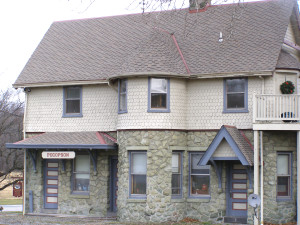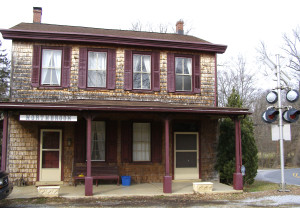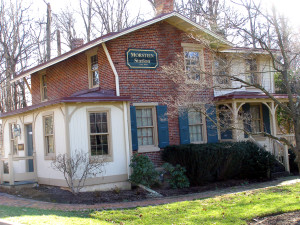By Gene Pisasale, Special to The Times

The Pocopson train station, located at the intersection of Route 926 and Pocopson Road opened to passenger service in 1890, but currently is home to veterinary practice.
Before superhighways, railroads dominated the landscape providing transportation for both passengers and heavy commodities. Pennsylvania ranked number one among all the states in the production of minerals from 1820 to 1920, necessitating improved access between commercial centers. Located near the bustling port of Philadelphia and the richly endowed farming and mining communities to the west and northwest, Chester County has a long and storied history with passenger railroads.
The early railroads were horse-pulled coaches on wooden rails lined with iron strips. On October 7, 1834 the line that would become the heart of the great Pennsylvania Railroad (PRR) opened, two trains leaving Columbia on the Susquehanna River going toward Philadelphia. The PRR became one of the dominant railroads in the United States, spurring dozens of branch lines as well as imitators around the nation. Many depots were built to accommodate travelers; over 25 of these structures still exist in Chester County.
The West Chester Railroad began operation in 1832. The line ran from West Chester to Malvern, where it connected with the Philadelphia and Columbia Railroad. The PRR began leasing the line in 1859 and re-routed the northern end to a connection with the main line at Frazer in 1880, becoming known as the “Frazer Branch”. Although passenger service on this branch ended in 1932, the PRR provided transport on the West Chester line until 1986.
The railroad came to Kennett Square on December 17, 1859 after a group of citizens formed a corporation to conduct an engineering survey for a rail line off of the Philadelphia- West Chester Railroad. The opening ceremony was a lavish affair, with a coronet band playing and cannons firing in celebration. The period between the Civil War and World War I was the golden age of the railroad in Kennett Square. The line was purchased by the Pennsylvania Eastern Railroad and later re-named the Octorara Branch of the Philadelphia and Baltimore Central. Both passenger and freight service occurred over the line, with local farmers providing corn and hay to Philadelphia customers. Though passenger service ended in 1948, the Kennett station still stands.
The very active Septa R5 line boasts several interesting depots. Strafford Station just off of Old Eagle School Road was constructed as the Catalogue Building for the Centennial Exposition in Philadelphia in 1876. The structure was purchased by the PRR and moved to its present location in 1887. Dark brown ornamental woodwork gives it a unique appearance. Devon Station was built in 1890 and its brownstone and clapboard façade flanks two red brick chimneys rising toward the sky. Berwyn Station, built in 1900, now houses a suite of businesses, but remains in superb shape with its brick walls and sloping metal awning alongside cheerful banners.
The recently closed Brandywine Scenic Railway wound its way through rural Chester County over an unusual rail line of numerous S-curves. Two privately owned depots still stand. The Northbrook Station, built in 1860 on the western branch of the Brandywine River, is just off of PA Route 842, next to the Northbrook Canoe Company. The building resembles a clapboard farmhouse, with rustic tan shingles and dark maroon wooden pillars standing at attention along the tracks. Pocopson Station was built in 1890, its strikingly green serpentine walls and buff-colored wood-shingled upper surface greeting visitors along PA Route 926. A station sign still hangs there. The building is in excellent condition, the ticket office now the examining room of the Pocopson Veterinary Station.
Some lesser known depots include the Morstein Station in West Whiteland Township which opened in 1840 and was part of the West Chester and Frazer Railroad. There is no town of Morstein; the station was likely named after a local farm. Built of sturdy red brick and tan clapboard, a prominent gold and forest green historical marker shines brightly on its side. Renovated in recent years, the building is one of the best examples of the early railroad stations. The tracks are long gone and the building is privately owned. A short distance west is the Whitford station (circa 1880), a tiny clapboard building situated below a towering ‘flyover’ girder bridge.
Many of the great train depots around Chester County have closed, victims of fires or urban planning. Yet some stalwart structures remain, a testament to a once-thriving railroad culture and a spirit that was sparked by a new mode of transport long ago… a spirit that survives today in these buildings which hold many proud memories.
Gene Pisasale has written two historical novels of Chester County. For more information visit his website at www.GenePisasale.com or e-mail him at Gene@GenePisasale.com









Good lucki